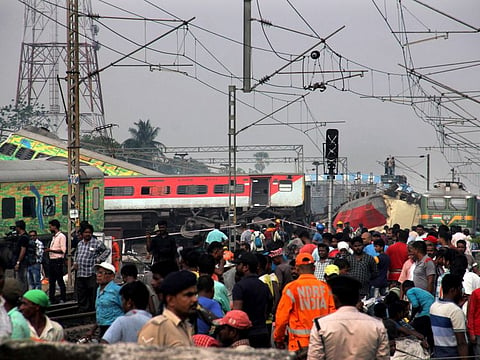Indian railways: How does Kavach system prevent train collisions?
There was no Train Collision Avoidance System on route where deadly rail crash occured

Dubai: The safety system developed by Indian Railways — known initially as the Train Collision Avoidance System (TCAS) — was later rebranded as Kavach, which translates to ‘armour’ in English.
In the wake of Friday night’s triple train collision in Odisha, which killed more than 280 passengers, Indian Railways has announced the acceleration of Kavach system installation along high-density routes.
Indian Railways spokesperson Amitabh Sharma has confirmed that there was no Kavach system on the route which could have helped avoid collision between the derailed bogies of Coromandel Express and Yeshwantpur-Howrah Express near Bahanaga railway station.
While the exact cause of the crash remains to be known, initial reports suggest a possible signalling failure, according to some railway officials.
The railways has initiated a high-level probe into the train crash in Odisha, which will be headed by the commissioner of railway safety, South Eastern Circle, officials said on Saturday.
The commissioner of railway safety works under the Ministry of Civil Aviation and investigates all such accidents.
When was Kavach introduced?
The Indian Railway ministry unveiled the indigenously created technology ‘Kavach’ in April last year in an effort to make rail transport safer.
Kavach automatically draws a locomotive to stop when it senses an obstruction on the track.
In 2022-23, Indian Railways expects to deploy Kavach on 2,000 railway path systems, with 4,000-5,000 rail channel networks installed each year after that.
Salient features of Kavach
* Kavach controls speed of the train by automatic application of brakes in case Loco Pilot fails to apply the brakes. * Repeats line-side signal in cab which is very useful for higher speeds and foggy weather. * Works on principle of continuous update of Movement authority. * Auto whistling at Level Crossing gates. * Collision avoidance by direct loco to loco communication. * Supports feature of SOS in case of any accident to control train in vicinity.
Following successful trial runs, Indian Railways has installed Kavach on only 1,445km of route so far, according to media reports.
The federal government last year floated a tender to bring a total of 3,000km of rail network under this technology, covering Delhi-Mumbai and Delhi-Howrah rail network.
Even after deploying on 3,000km of the rail network, the armour will be missing on over 95 per cent of Indian Railways’ routes, reports said.
What is the Kavach system?
Kavach is a collection of electronic gadgets and Radio Frequency Identification (RFID) systems set up in locomotives, signalling systems and tracks. These components communicate using ultra-high radio frequencies, enabling them to control train brakes and alert drivers based on pre-programmed logic. The system incorporates key features from other successful safety systems like the European Train Protection and Warning System, as well as the indigenous Anti-Collision Device. Kavach complies with the rigorous Safety Integrity Level (SIL) 4 standard, ensuring the highest level of safety and reliability.
How does it work?
When activated, Kavach stops all trains within a 5-km radius, safeguarding trains on adjacent tracks. This feature eliminates the reliance on loco-pilots and assistant loco-pilots to identify caution signs and signals, significantly reducing the risk of human error. The technology also includes stationary equipment that collects signalling inputs and transmits them seamlessly to train crews and stations, enhancing communication across the network.
Kavach also alerts when a loco pilot jumps a signal (Signal Passed at Danger -- SPAD), which is the leading cause of train collisions. The system can alert the loco pilot take control of the brakes and bring the train to a halt automatically when it notices another train on the same line within a prescribed distance.
How safe is the technology?
The technology is Safety Integrity Level 4 (SIL-4) certified, the highest certification level. It means that there is a probability of just one error by Kavach in 10,000 years.
The operation cost of the anti-collision system is Rs5 million per km, which is significantly lower than the cost of such technology used in other nations.
Sign up for the Daily Briefing
Get the latest news and updates straight to your inbox

